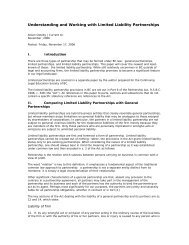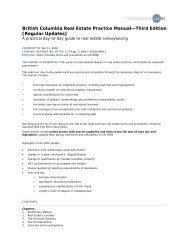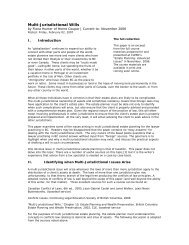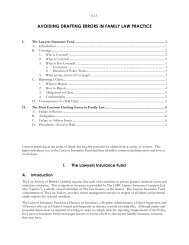Joint Ventures-The Limited Fiduciary Relationship Structure
Joint Ventures-The Limited Fiduciary Relationship Structure
Joint Ventures-The Limited Fiduciary Relationship Structure
Create successful ePaper yourself
Turn your PDF publications into a flip-book with our unique Google optimized e-Paper software.
5.1.14<br />
B. Participation and Management Roles of the Parties<br />
<strong>The</strong> JV is typically governed by a management committee comprised of representatives of each<br />
participant in the JV. Establishing the degree of control that each participant has over the JV’s<br />
activities is a key element of negotiating the JV agreement. As each participant’s contribution to the<br />
JV is usually of a different kind, including cash, expertise, technology or resource prospects, it is<br />
important to weigh the degree of control in the JV which is required by a participant to offset the<br />
commercial risks that that particular participant is assuming in regards to its contributions by<br />
participating in the JV. For example, a participant which contributes a minority of the assets, or assets<br />
which are fungible, such as cash, may have less need to control the JV’s activities than one<br />
contributing proprietary technology which is at the root of its existing business. <strong>The</strong> degree of<br />
control necessary to a participant is also generally in line with the dollar magnitude of the participant’s<br />
contributions. For example, one would normally expect the party contributing 80% of the JV assets<br />
to have a great degree of freedom of action in operating the JV on behalf of itself and the 20%<br />
participant.<br />
It is typical for a JV to establish that one participant or a third party under a contract will operate the<br />
JV under the direction of the management committee. <strong>The</strong> management committee makes its<br />
decisions typically by the representatives voting in proportion to the percentage interests that they<br />
represent. Thus, where one party has more than 50% participating interest, it is said to “drive the<br />
bus.” However, the minority interest holders will typically seek a unanimity requirement for certain<br />
kinds of decisions. Clearly, the greater the detail in a JV agreement which specifies what the JV is to<br />
do, the less scope exists for deal-changing decision making issues to arise.<br />
A key point to recognize is that control of the management committee is usually linked to changes in<br />
the participating interests of the parties through funding and dilution provisions. <strong>The</strong> JV agreement<br />
will typically provide for one or more budgets annually for the JV which needs to be funded by the<br />
participants. Before the JV budget is adopted by the management committee, each participant is<br />
generally provided an opportunity to comment on it. After the budget is adopted (usually by a<br />
majority of votes on the management committee) each participant which is to maintain its<br />
participating interest in the JV, must fund its share of costs budgeted or else may elect to fund a<br />
smaller share or decline altogether. <strong>The</strong> consequences of failing to fund are usually that the declining<br />
party’s participating interest in the JV is diluted to a lesser percentage with the lost points of<br />
participating interest being distributed proportionately among those participants who elect to fund.<br />
<strong>The</strong>re are many different types of dilution formulas from “straight line,” which is the reduction in<br />
participating interest is equal to the proportion of missed funding divided by aggregate funding, or<br />
some multiple of straight line dilution especially at key risk points in the JV’s project life. For<br />
example, with straight line dilution, the decision on the part of Party A to not participate in the next<br />
$1 million approved budget in a 50:50 JV which has already spent $9 million to date, will result in a<br />
5% dilution to Party A ($500k/$10M). Henceforth, that JV will be a 45:55 JV and the parties will<br />
fund accordingly. Some JV agreements provide that where a party declines to participate twice, it is<br />
no longer open to that party to elect to participate in further expenditures. <strong>The</strong> non-participating<br />
party will thereafter suffer dilution if the other parties continue to fund, although the nonparticipating<br />
party will generally retain some interest, such as a royalty, for the funds risked to the<br />
point where it ceases to participate in funding.<br />
<strong>The</strong> dilution formula must relate to the degree of risk of the monies involved, which is dependent on<br />
the stage of the JV project that the funds are to be expended upon. Monies needed for a high-risk<br />
phase should result in much larger dilution than failure to fund a low-risk phase. <strong>The</strong> point to<br />
recognize is that because the budget is set by the holders of the majority participating interests (the bus<br />
drivers), they can determine the speed of the bus and if some of the passengers cannot afford the ticket,<br />
the bus will drop them off early. <strong>The</strong> participating interest to dilution linkage can become a vicious<br />
cycle where for example the minority voting partner is unable to control or influence an increasing<br />
level of JV expenditures, which it then cannot match, and suffers a continual erosion of its<br />
participation and voting rights in the JV, leading again to fewer votes in determining the level of JV
















